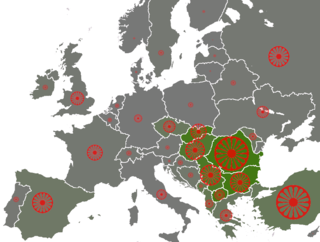
The Romani people, also known as the Roma, are an ethnic group of Indo-Aryan origin who traditionally lived a nomadic, itinerant lifestyle. Linguistic and genetic evidence suggests that the Roma originated in the Indian subcontinent, in particular the region of Rajasthan. Their first wave of westward migration is believed to have occurred sometime between the 5th and 11th centuries. They are thought to have arrived in Europe around the 13th to 14th century. Although they are widely dispersed, their most concentrated populations are believed to be in Bulgaria, Hungary, Romania, Serbia and Slovakia.

The Romani Holocaust was the planned effort by Nazi Germany and its World War II allies and collaborators to commit ethnic cleansing and eventually genocide against European Roma and Sinti peoples during the Holocaust era.

Romani music is the music of the Romani people who have their origins in northern India but today live mostly in Europe.
The Dom are descendants of the Dom caste with origins in the Indian subcontinent which through ancient migrations are found scattered across the Middle East and North Africa, the Eastern Anatolia Region, and parts of the Balkans and Hungary. The traditional language of the Dom is Domari, an endangered Indo-Aryan language, thereby making the Dom an Indo-Aryan ethnic group.

The Lom people, also known by non-Loms as Bosha or Posha or as Armenian Romani or Caucasian Romani, are an ethnic group originating from the Indian subcontinent. Their Lomavren language is a mixed language, combining an Indo-Aryan substrate with Armenian.

The Romanichal are a Romani subgroup within the United Kingdom and other parts of the English-speaking world. Most Romanichal speak Angloromani, a mixed language that blends Romani vocabulary with English syntax. Romanichal residing in England, Scotland, and Wales are part of the Gypsy, Roma, and Traveller community.

Romani people in Romania, locally referred to as the Țigani, constitute one of the largest minorities in the country. According to the 2011 census, their number was 621,573 people or 3.3% of the total population, being the second-largest ethnic minority in Romania after Hungarians. There are different estimates about the size of the total population of people with Romani ancestry in Romania, varying from 4.6 percent to over 10 percent of the population, because many people of Romani descent do not declare themselves Roma. For example, in 2007 the Council of Europe estimated that approximately 1.85 million Roma lived in Romania, based on an average between the lowest estimate and the highest estimate available at the time. This figure is equivalent to 8.32% of the population.

The Romani people are a distinct ethnic and cultural group of peoples living all across the globe, who share a family of languages and sometimes a traditional nomadic mode of life. Though their exact origins were unclear, recent studies show Kashmir in Northwest India is the most probable point of origin. Their language shares a common origin with, and is similar to, modern-day Gujarati and Rajasthani, borrowing loanwords from languages they encountered as they migrated from India. In Europe, even though their culture has been victimized by other cultures, they have still found a way to maintain their heritage and society. Indian elements in Romani culture are limited, with the exception of the language. Romani culture focuses heavily on family. The Roma traditionally live according to relatively strict moral codes. The ethnic culture of the Romani people who live in central, eastern and southeastern European countries developed through a long, complex process of continuous active interaction with the culture of their surrounding European population.

The Lyuli, Jughi or Jugi are a branch of the Ghorbati people living in Central Asia, primarily Tajikistan, Uzbekistan, Turkmenistan, Kazakhstan, and southern Kyrgyzstan; also, related groups can be found in Turkey, and the Balkans, Crimea, Southern Russia and Afghanistan. They speak ethnolects of the Persian and Turkic language and practice Sunni Islam. The terms Lyuli and Jugi are considered pejorative. They have a clan organization. Division into sub-clans is also practiced. The Lyuli community is extremely closed towards non-Lyuli.

Anti-Romani sentiment is a form of bigotry which consists of hostility, prejudice, discrimination, racism and xenophobia which is specifically directed at Romani people. Non-Romani itinerant groups in Europe such as the Yenish, Irish and Highland Travellers are frequently given the name "gypsy" and as a result, they are frequently confused with the Romani people. As a result, sentiments which were originally directed at the Romani people are also directed at other traveler groups and they are frequently referred to as "antigypsy" sentiments.

The Romani people have several distinct populations, the largest being the Roma and the Calé, who reached Anatolia and the Balkans in the early 12th century, from a migration out of the Indian subcontinent beginning about 1st century – 2nd century AD. They settled in the areas of present-day Turkey, Greece, Serbia, Romania, Croatia, Moldova, Bulgaria, North Macedonia, Hungary, Albania, Kosovo, Bosnia and Herzegovina, Czech Republic, Slovenia and Slovakia, by order of volume, and Spain. From the Balkans, they migrated throughout Europe and, in the nineteenth and later centuries, to the Americas. The Roma population in the United States is estimated at more than one million.
Scottish Romani are the Romani people of Scotland. This includes Romanichal and Lowland Roma.

The Ruska Roma, also known as Russian Gypsies or Khaladitka Roma, are the largest subgroup of Romani people in Russia and Belarus, with smaller remnants of the group living in Ukraine, Latvia, Poland, the United States, France, and Canada. They formed in the Northwestern part of the Russian Empire from the Polska Roma who immigrated to the country in the 18th century.

Muslim Romani people are people who are ethnically Roma and profess Islam. There are many different Roma groups and subgroups that predominantly practice Islam, as well as individual Romani people from other subethnic groups who have accepted Islam. Xoraxane Roma in Balkan Romani language, are non-Vlax Romani people, who adopted Sunni Islam of the Hanafi madhhab at the time of the Ottoman Empire. Some of them are Derviş of Sufism belief, and the biggest Tariqa of Jerrahi is located at the largest Arlije and Gurbeti Muslim Roma settlement in Europe in Šuto Orizari, locally called Shutka in North Macedonia have their own Romani Imam and the Muslim Roma in Šuto Orizari use the Quran in Balkan Romani language. Many Romanlar in Turkey, are members of the Hindiler Tekkesi a Qadiriyya-Tariqa, founded in 1738 by the Indian Muslim Sheykh Seyfullah Efendi El Hindi in Selamsız. Roma Muslims in Turkey and the Balkans are mostly cultural Muslims or nominal Muslims.
The Romani people in Turkey or Turks of Romani background are Turkish citizens and the biggest subgroup of the Turkish Roma. They are Sunni Muslims mostly of Sufi orientation, who speak Turkish as their first language, in their own accent, and have adopted Turkish culture. Many have denied their Romani background over the centuries in order to establish a Turkish identity, to become more accepted by the host population.
The Romani people are known by a variety of names, mostly as Gypsies, Roma, Tsinganoi, Bohémiens, and various linguistic variations of these names. There are also numerous subgroups and clans with their own self-designations, such as the Sinti, Kalderash, Boyash, Manouche, Lovari, Lăutari, Machvaya, Romanichal, Romanisael, Kale, Kaale, Xoraxai and Modyar.

Romani Americans are Americans who have full or partial Romani ancestry. It is estimated that there are one million Romani people in the United States. Though the Romani population in the United States has largely assimilated into American society, the largest concentrations are in Southern California, the Pacific Northwest, Southwestern United States, Texas, Louisiana, Florida and the Northeast as well as in cities such as Chicago, Cleveland, and St. Louis.
The Romani people in Canada are citizens of Canada who are of Romani descent. According to the 2021 Canadian census there were 6,545 Canadians who claimed Romani ancestry. They are sometimes referred as "gypsies", but that is considered to be a racial slur.

The Romani people in Australia are citizens of Australia who are of Romani descent. They are sometimes referred to as Roma. Most Roma in Australia trace their roots to the United Kingdom and Greece, who in return trace their roots to northern India.

Romani people have been recorded in the United Kingdom since at least the early 16th century. There are estimated to be around 225,000 Romani residing in the UK. This includes the Romanichal, Kale, Scottish Lowland Roma and a sizeable population of Roma from Continental Europe, who immigrated into the UK in the late 1990s/early 2000s and after EU expansion in 2004. They are considered part of the Gypsy, Roma and Traveller (GRT) community.














